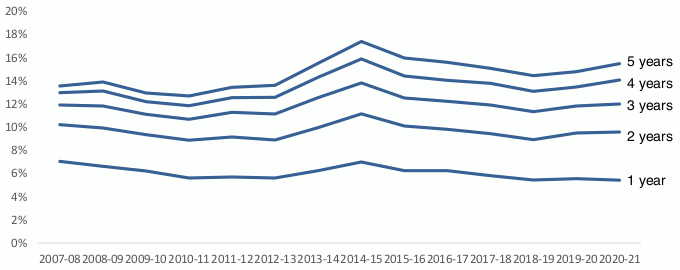Homelessness in Scotland: 2020 to 2021
This statistics bulletin provides information on homelessness in Scotland in the period from 1 April 2020 to 31 March 2021, alongside historical data.
Outcomes
Key Points
- 80% of households secure settled accommodation, increasing from 64% in 2002/03 but falling from 83% in 2019/20.
- 5% of homeless households had previously been assessed as homeless in the previous 12 months, and 15% in the previous 5 years.
Homelessness cases are closed once the local authority has fulfilled its statutory duty or contact has been lost with the applicant household for 28 days. Local authorities provide information on the circumstances and outcomes of homelessness cases once they have been closed.
Number of cases closed
The number of homelessness applications that were closed declined following the outbreak in COVID-19. As a result, there were 11% fewer homelessness cases closed in 2020/21 for applications assessed as unintentionally homeless or threatened with homelessness (25,331 compared to 28,591). This was due to COVID-19 restrictions at this time limiting the ability of local authority staff to move households into permanent accommodation. Similarly, there were 53% fewer intentionally homelessness cases closed over the same period (from 573 to 1,219). (Table 44)
How often do local authorities lose contact with applicants?
For households assessed in 2020/21, contact was maintined for 92% of those assessed as unintentionally homeless and for 88% assessed as intentionally homeless.[10]
The proportion of applicants maintaining contact has increased over time for unintentionally homeless households, from 81% in 2007/08. For intentionally homeless households, the proportion has remained stable in recent years. (Table 44)
What are the outcomes for homeless households?
Of the 22,967 unintentionally homelessness cases that closed in 2020/21 (where contact was maintained and the outcome was known), 80% (18,313) secured settled accommodation as their outcome. Settled accommodation here is defined as a local authority tenancy (which accounted for 42% of outcomes), a tenancy with a registered social landlord (32%) or a private rented tenancy (5%).
The remaining outcomes were ‘Other (known)’ (8%), ‘Returned to previous/present accommodation’ (6%), ‘Moved in with friends/relatives’ (5%) and ‘Hostel’ (1%).
The proportion of unintentionally homeless households securing settled accommodation has increased over time, from 64% in 2002/03 to 83% in 2019/20. This fell to 80% however in 2020/21, with reduced proportion of households entering a local authority tenancy (42% compared to 47% in 2019/20). There was a notable fall in the months immediately following the outbreak ov Covid-19, with 73% of cases closed in April to June 2020 securing settled accommodation in this period among those assessed as unintentionally homeless. Intentionally homeless households are less likely to secure settled accommodation, with 44% doing so in 2019/20. (Tables 46, 47 & 59)
Local connection referrals
In 2020/21, 240 homeless households were referred to another local authority. This number has fallen from 390 in 2005/06, but increased from 175 in 2019/20. This decline has largely been driven by Glasgow, which referred 0 cases in 2019/20 compared to 150 in 2005/06. (Table 52)
Is there a return to homelessness?
In order to understand the longer-term outcomes for homeless households, and whether outcomes upon case closure are sustained, there is interest in ‘repeat homelessness’ i.e. where households previously assessed as homeless re-enter the homelessness system at a later point in time. Chart 14 shows the proportion of households assessed as homeless that were previously assessed as homeless in the last 1, 2, 3, 4 and 5 years[11] from 2007-08 to 2020-21. There were 1,495 households (5%) that had previously been assessed as homeless in the 12 months prior to their most recent assessments, increasing to 4,269 (15%) in the previous 5 years. These proportions have decreased since 2014/15. (Table 16)

There is significant local variation between local authorities with respect to repeat homelessness. For example, 14% of households assessed as homeless in Inverclyde had previously been assessed as homeless in the 12 months prior to their assessment, compared to 0% in Shetland, though all are based on relatively small numbers. (Table 17)
Were Housing Support assessments carried out and housing support provided?
Upon closing a homelessness case, local authorities are required to assess whether any housing support services are required by the household for any cases assessed as unintentionally homeless and where it has reason to believe that support would be beneficial. It also has a duty to provide that support if needed.
Across Scotland, assessments for housing support needs were carried out in 80% of cases where there was a duty to assess in 2020/21. Housing support was provided in 43% of all cases, although support was not provided for 8% of cases where a support need was identified. In 20% of cases where there was a duty to assess, no assessment took place and no support was provided. (Table 53)
Contact
There is a problem
Thanks for your feedback